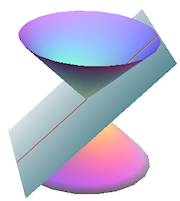Conic sections - summary
This is a summary of the first 5 topics in this chapter: straight line, circle, parabola, ellipse and hyperbola.
Don't miss the 3D interactive graph, where you can explore these conic sections by slicing a double cone.
Straight Line

Slope-intercept Form
The equation of a line with slope m and y-intercept b is given by:
y = mx + b

Point-slope form
The equation of a line passing through a point (x1, y1) with slope m:
y − y1 = m(x − x1)
General Form of a Straight Line
`Ax + By + C = 0`

Conic Section
If we slice the double cone by a plane just touching one edge of the double cone, the intersection is a straight line, as shown.
For background and examples, see Straight Line.
Circle

The circle with centre (0, 0) and radius r has the equation:
x2 + y2 = r2

The circle with centre (h, k) and radius r has the equation:
(x − h)2 + (y − k)2 = r2
General Form of the Circle
An equation which can be written in the following form (with constants D, E, F) represents a circle:
x2 + y2 + Dx + Ey + F = 0
Conic Section

If we slice one of the cones with a plane at right angles to the axis of the cone, the shape formed is a circle.
For background and examples, see Circle.
Parabola

Parabola with Vertical Axis
A parabola with focal distance p has equation:
x2 = 4py
In more familiar form, with "y = " on the left, we can write this as:
`y=x^2/(4p)`

If the axis of a parabola is vertical, and the vertex is at (h, k), we have
(x − h)2 = 4p(y − k)

Parabola with Horizontal Axis
In this case, we have the relation:
y2 = 4px

If the axis of a parabola is horizontal, and the vertex is at (h, k), the equation becomes
(y − k)2 = 4p(x − h)
Formal Definition
A parabola is the locus of points that are equidistant from a point (the focus) and a line (the directrix).
Conic Section
If we slice a cone parallel to the slant edge of the cone, the resulting shape is a parabola, as shown.


For background and examples, see Parabola.
Ellipse
Horizontal Major Axis

The equation for an ellipse with a horizontal major axis and center (0,0) is given by:
`x^2/a^2+y^2/b^2=1`
The foci (plural of 'focus') of the ellipse (with horizontal major axis) are at `(-c,0)` and `(c,0)`, where c is given by:
`c=sqrt(a^2-b^2`
The vertices of an ellipse are at `(-a, 0)` and `(a, 0)`.

An ellipse with horizontal major axis and with center at (h, k) is given by:
`((x-h)^2)/a^2+((y-k)^2)/b^2=1`
Vertical Major Axis

If the major axis is vertical, then the formula becomes:
`x^2/b^2+y^2/a^2=1`
We always choose our a and b such that a > b.
Formal Definition
An ellipse is the locus of points whereby the sum of the distances from 2 fixed points (the foci) is constant.
Conic Section
When we slice one of the cones at an angle to the sides of the cone, we get an ellipse, as seen in the view from the top (at right).


For background and examples, see Ellipse.
Hyperbola
North-south Opening

For a north-south opening hyperbola:
`y^2/a^2-x^2/b^2=1`
The slopes of the asymptotes are given by:
`+-a/b`

For a "north-south" opening hyperbola with centre (h, k), we have:
`((y-k)^2)/a^2-((x-h)^2)/b^2=1`
East-west Opening

For an east-west opening hyperbola:
`x^2/a^2-y^2/b^2=1`
The slopes of the asymptotes are given by:
`+-b/a`

For an "east-west" opening hyperbola with centre (h, k), we have:
`((x-h)^2)/a^2-((y-k)^2)/b^2=1`
Formal Definition
A hyperbola is the locus of points where the difference in the distance to two fixed foci is constant.
General Form of a Hyperbola
`Ax^2 + Bxy + Cy^2 + Dx + Ey + F` ` = 0`
(such that `B^2>4AC`)
Conic Section
When we slice our double cone such that the plane passes througn both cones, we get a hyperbola, as shown.

For background and examples, see Hyperbola.
Also, don't miss the 3D interactive graph, where you can explore these conic sections by slicing a double cone.